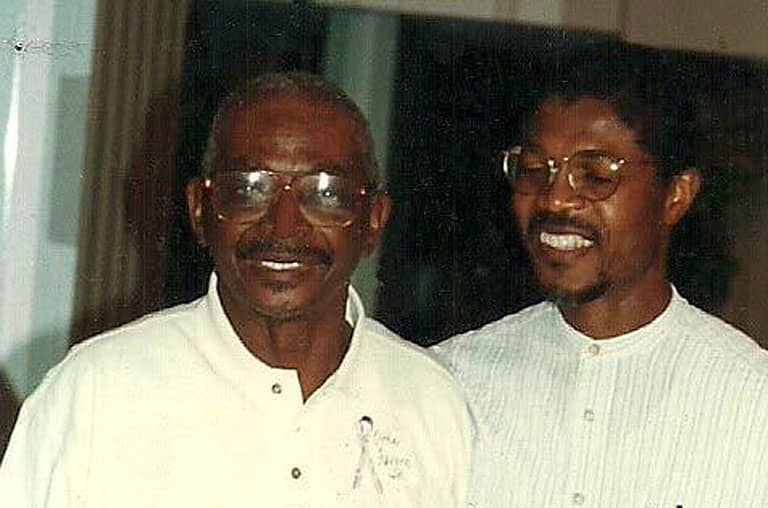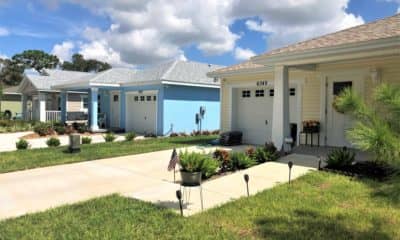Thrive
Waveney Ann Moore: Making Tropicana Field right

As four groups maneuver to be selected to redevelop the Tropicana Field site, Black St. Petersburg residents whose lives have been closely linked to it are sharing their stories and hopes for its future.

Imam Askia Muhammad Aquil
As a little boy, Imam Askia Muhammad Aquil remembers riding with his mother in the family car to take lunch to his father at his job at the Gas Plant site. The natural gas plant, owned by the city, gave the family of six a secure financial foundation and served as a launching pad to entrepreneurship.
Aquil’s story is just one of many associated with the Gas Plant neighborhoods – there were several – that formed a diverse socioeconomic community.
The stories come as the city’s Black residents speak openly of their disappointment, even anger, about how the area in which they had been forced to live because of segregation was taken from them without the promised compensation of jobs, business opportunities and better housing.
Aquil, now 75, didn’t grow up in the Gas Plant area, but his life in Methodist Town – another Black community a few blocks to the north – was closely linked to the area. It wasn’t just because of his father’s city job at the Gas Plant. His friends lived there too. He walked to his school, Davis Elementary, in the Gas Plant area. It was where the Harlem Theater was located and where, on Saturday afternoons, he and his friends, sisters and brother saw Tarzan and Hopalong Cassidy movies.
The structures would all vanish in the city’s pursuit of Major League Baseball.
“Gas Plant redevelopment caused 285 buildings to be bulldozed: more than 500 households and 9 churches had to be relocated; and more than 30 businesses moved and closed,” wrote Rosalie Peck and Jon Wilson in their book, St Petersburg’s Historic African American Neighborhoods.
“Tenements and shacks disappeared, but so did the fine homes in places like Sugar Hill, where the elegant Ponder home and its beloved cherry hedge disappeared, as did a score of other well-appointed houses,” the authors said.
The Ponders, incidentally, were Fannye Ayer Ponder – founder of the St. Petersburg National Council of Negro Women Metropolitan Section and a close friend of Mary McLeod Bethune – and her husband, Dr. James Ponder.
Though he knew of Sugar Hill, Aquil said it wasn’t an area where he went as a child.
“We were aware that some people were a little better off than others,” he said. “(But) we all lived together, went to school together, worshiped together. We were segregated, but not divided by class … We were taught manners, to treat adults with respect. Family life was very structured.”
Aquil, father of five daughters, among them triplets, and two sons, remains close to childhood friends from the Gas Plant area, including former Florida Rep. Rudy Bradley. “His family’s home was next to the Harlem Theater,” Aquil said. “I had another childhood friend whose grandmother lived adjacent to the Harlem Theater.”
The Black community was close in those days. Aquil gave as an example his connection to the principal of Davis Elementary, Amanda Howard: “I would see her at school and then see her at church on Sunday and then see her as a neighbor.”
He went on to junior high near the Gas Plant area. That junior high, now John Hopkins Middle School, sits close enough to Tropicana Field to allow its parking lot to be used by some people when they attend baseball games at the stadium.
Aquil, now 75, is well known in St. Petersburg’s African-American community. He’s active in Tampa Bay-area interfaith circles, is a longtime advocate for affordable housing and is a former trustee for the Foundation for a Healthy St. Petersburg.
He also recently joined one of the teams vying to redevelop the Tropicana site. In a nod to the area, the team he’s aligned with calls itself Sugar Hill Community Partners. Aquil said there were two motivating factors for wanting to be part of what happens at the site.
“Obviously, the rich history and the fond memories I have, representing so many of my formative years in the Gas Plant neighborhood, going to school, visiting and hanging out with friends. And there was a library on Third Avenue. And because the area was vibrant and because of the positive energy and entrepreneurial drive of the people who lived there. It was a springboard for those who were seeking to move up to the middle class and the upper middle class. They were positive role models,” he said.
“The second reason is, I am familiar with the promises that were made to the community as a whole when the city decided they wanted to clear that land and eventually use it to build a stadium.”
The neighborhood was systematically dismantled, he said, a strategy that was also employed in Methodist Town, where Historic Bethel AME Church still stands proudly. It was his family’s church, said Aquil, who converted to the Islamic faith in 1970 and later changed his name from Otha Favors Jr.
This week, Aquil spoke of the process authorities have used to dismantle Black communities, first by declaring them an area of blight and then promising improvements.
“Typically, there is an initial plan, then it is modified and replaced with a different plan,” he said, adding that the process involves “steadily moving people” and assembling large parcels of land for the government’s benefit.
“Remember, there was never any big community assembly saying this is what we want to do,” he said. “It didn’t happen. It was kind of kicking out people one at a time, one owner at a time, one renter at a time. People would talk to you, ‘Here’s what we want to offer.’ I believe that eminent domain was used in some cases and that fair market rates might have been offered.”
The stadium was built, but with little benefit to the community it displaced, Aquil said. Traffic from ball games, concerts and other events is directed away from Black neighborhoods and businesses to the south.
“There was no effort to encourage people to spend with some of those businesses,” he said. “There was nothing done that created this tidal wave of opportunities.”
Aquil was working for the St. Petersburg Housing Authority when Laurel Park, a public housing development adjacent to the Gas Plant area, was sold to the city. The units that housed Black people were demolished and the property turned into a stadium parking lot.
The effort to redevelop the Tropicana Field site is crucial, Aquil said. “I think this is absolutely an opportunity to make things right.”








LjC
December 10, 2022at3:56 pm
Mr. Sima Damian, where did you get your information from, it’s not accurate. It doesn’t represent the area I grew up in or I remember. But, typically these are the talking points used to discourage the contributions of the African-American community. I think you may have been referring to 4th Street and 9th avenue North.
Arty
December 10, 2022at2:09 pm
I can’t believe this happened. I’ve heard the same story from others I’ve met around St Petersburg. Returning Tropicana Field entirely to the historic community is the right thing to do. The cruelty of restricting a community to one location and then taking what they built up away from them is absolutely despicable.
Shauntee Favors
December 10, 2022at12:36 pm
Sima is definitely a liar. I can tell by the way he speaks on Tropicana he did not live in that area growing up and may only be speaking on the narrative pushed to him which is how they speak on any area the govt wants to steal back from the community. The area was not run down and riddled with crime. Just as Askia said it was a community of working class black folks thriving during a time where segregation was alive. Crime is everywhere and not just in working class black communities. Everybody knew everyone so there was little room to commit a crime and someone tell your family soon thereafter. Times were very different then. Villages were in tact.
Shirley Hayes
December 10, 2022at9:00 am
This Simi Damijan is a complete liar. I lived in the Gas Plant area and it was safe. I did not witness any crime. We were a close knit community. They lied to us as usual and had an alternative plan.
Sima Damijan
December 9, 2022at11:25 pm
I don’t know what fantasy land this gentleman lives in but I can tell you well before The Suncoast dome was even talked about the gaslight district was a complete disaster area with crime,drugs and prostitution running ramped.
I challenge this man to say any different and I he does he’s a baldface liar.
Simply put the best thing that could of ever happened to the area was The Suncoast dome.
Don’t be fooled by this untrue depiction of the troubled gaslight district. It was no a good place.